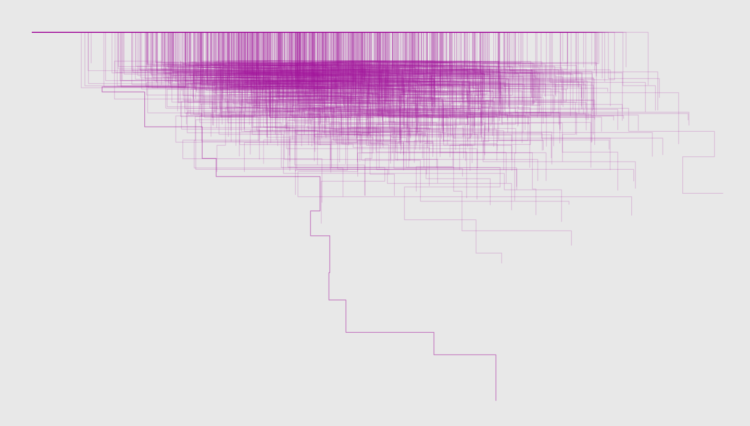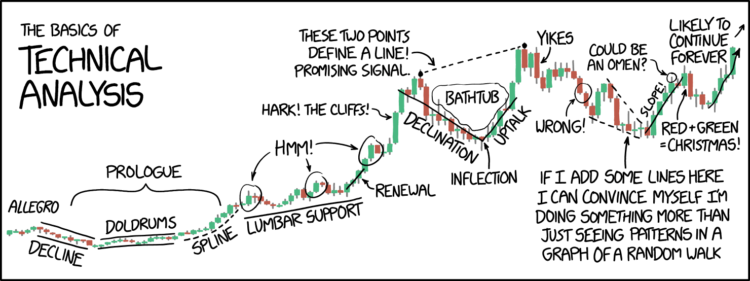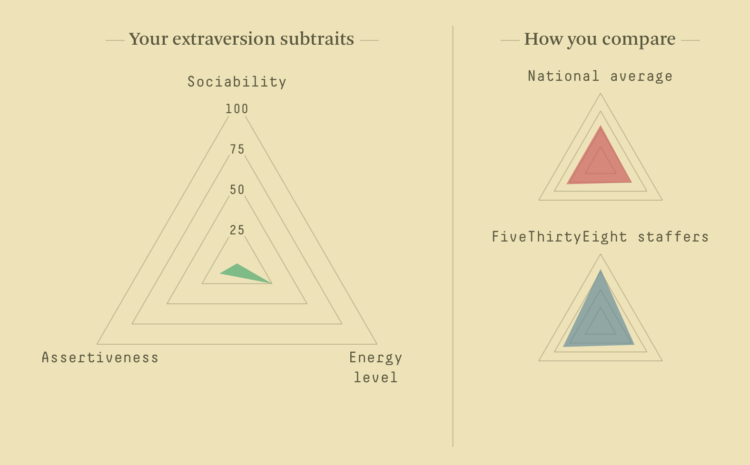Using a year’s worth of daily images from NASA’s Visible Infrared Imaging Radiometer Suite (VIIRS), Johannes Kroeger constructed the average snapshot for 2018. Fun.
-
Many parents stop at two kids. Most are done by three. Still, everyone has their own timelines. Here are 1,000 of them.
-
Members Only
-
A wideout view of the news cycle can look like a series of rise and falls. Something captures the general public’s attention, and then it fades off. Thank you, next. This collaboration between Schema Design and Google Trends charts search volume for news stories and aligns them by their peaks, so that you can see these rise and falls.
Transparent areas overlaid on each other show an “average” trend, and the more irregular shapes are made obvious because they stand out from the rest.
See also the simpler view by Axios, who contributed stories to the project.
-
Matt Baker provides this nifty diagram on how the alphabet changed over the centuries, evolving to what it is now. Grab the print.
-
Cartoonist Olivia de Recat illustrated the closeness over time for various relationships. Charming. Unfortunately, the print is sold out. Sad trombone.
-
How to Make a Mosaic Plot in R
Also known as a Marimekko diagram, the mosaic plot lets you compare multiple qualitative variables at once. They can be useful, sometimes.
-
First comes love, then comes marriage, then comes baby in the baby carriage. Sometimes.
-
For The New York Times, Sahil Chinoy and Jessia Ma visualized the path to Congress for every member. See it all at once like above or search for specific members. The vertical scale represents previous categories of work and education and looks like it’s sorted by how common the categories were among Republicans and Democrats. The horizontal scale represents time, which starts at undergraduate and finishes at the House. Nice.
-
We looked at prime dating age and when people usually marry. Now it’s time for the next step in the circle of life.
-
Members Only
-
Sarah Weber posted a picture of a scarf that her mom knit to represent rail delays. Weber’s mom knitted two rows per day and used color to indicate the delay. Grey was under 5 minutes, pink was 5 to 30 minutes, and red was over 30 minutes.
After getting some attention on the Twitters, the mom opted to put it up on eBay to benefit charity Bahnofs Mission. It went for $7,550 euros. Nice.
-
I’m always up for some scaled perspective. From David Packer:
Anyone need a video demonstrating 1000s, 100s, 10s and 1s? You're in luck pic.twitter.com/sMGKlXKVy7
— Dave (@sheepfilms) January 21, 2019
-
DataKind, the organization known for helping others use data for social good, received a $20 million grant from The Rockefeller Foundation and the Mastercard Center for Inclusive Growth:
The grant will allow DataKind to transition from a project to a platform-based model, thereby, supporting more organizations on a set of high impact areas, such as community health and inclusive growth. We’re humbled and honored that these two groups are supporting our mission with $20M over five years to help us grow to support the needs of the sector.
Awesome.
-
Some words are harder to spell than others, and on the internet, sometimes people indicate the difficulty by following their uncertainty with “(sp?)”. Colin Morris collected all the words in reddit threads with this uncertainty. Download the data on GitHub.
-
Hurry up, light. We’re gonna be late:
By James O’Donoghue, the animation shows the speed of light in real-time. The distance between Earth, the moon, and Mars is to scale, but the locations are scaled up so that you can see them.
See also the animations for Earth to the moon and of light orbiting Earth.
-
Ah, the online personality quiz, oh how I missed you. Oh wait, this one is slightly different. For FiveThirtyEight, Maggie Koerth-Baker and Julia Wolfe provide a quiz used by psychologists to gauge personality traits:
First, the Big Five doesn’t put people into neat personality “types,” because that’s not how personalities really work. Instead, the quiz gives you a score on five different traits: extraversion, agreeableness, conscientiousness, negative emotionality and openness to experience. For each of those traits, you’re graded on a scale from 0 to 100, depending on how strongly you associate with that trait. So, for example, this quiz won’t tell you whether you’re an extravert or an introvert — instead, it tells you your propensity toward extraversion. Every trait is graded on a spectrum, with a few people far out on the extremes and a lot of people in the middle.
Dang it. I really wanted to know what Harry Potter character I am.
-
Members Only
-
John Nelson turned the Grand Canyon inside out to understand the magnitude better:
Some of my earliest memories of the place had to do with the trippy feeling of my eyes and mind trying to make sense of the scale. I had seen many mountain ranges and vistas, including some on the way, but the vast negative space played havoc with my perception of magnitude. I’ve felt it a few times since, but never like that first Grand Canyon overlook.
Instructions included on how to do this in ArcGIS Pro.


















 Visualize This: The FlowingData Guide to Design, Visualization, and Statistics (2nd Edition)
Visualize This: The FlowingData Guide to Design, Visualization, and Statistics (2nd Edition)










